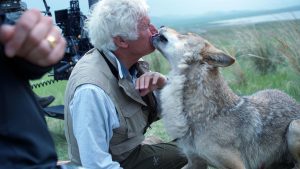Many regard the 2016 film Born in China as a surprise hit for Chinese cinemas.
First shown in August, the joint production by Disneynature and Chinese director Lu Chuan has wowed audiences with gorgeous cinematography and a dramatic plot, earning over 60 million yuan (US$9 million) in its first six weeks at the box office.
This is a rare success for a wildlife film in China, where small- to medium-budget films and those with an educational theme, rarely do well commercially.
Uncertain categorisation
A major selling point for the film was its description in the media as China’s first wildlife drama. The film uses documentary footage of three animal families: a female panda bear and her cub; a two-year-old golden snub-nosed monkey and his new-born sister; and a female snow leopard and her cubs. The film is set amidst stunning scenery in Qinghai, Sichuan and Heilongjiang provinces, among others, and features Tibetan antelopes and red-crowned cranes.
This is a new type of film for Chinese audiences and one that has resulted in a lot of debate about how to categorise it. Cinemagoers have generally seen it as a documentary. On leaving cinemas, they have fretted about the welfare and fate of the animals and debated on social media whether the production team should have intervened to help them. The film even won the best documentary award at the 3rd Silk Road International Film Festival held in Xi’an in September.
However, critics have argued that the film is not a documentary and that it belongs in its own category as a wildlife drama. Reviewers have complained that the wildlife drama genre hides the harsh realities of nature, misrepresents the struggle for survival between different animal populations, and anthropomorphises animal life.
The Disney way
Despite a non-interventionist approach to filming, part of the film’s success in winning over audiences may be attributed to the application of Disney’s uniquely recognisable story-telling style.
Disney has a long history of anthropomorphism in its films – from the early Mickey Mouse to the recent re-telling of The Jungle Book, and while Born in China uses real footage of animals rather than hand-drawn or computer-generated characters, it emphasises the joyful and comic elements present in all Disney films.
This approach contrasts quite strongly with some of director Lu Chuan’s other works, which have relied on a pure documentary style.
Lu’s award-winning 2004 film, Kekexili, portrayed the tragedy of rampant poaching of Tibetan antelopes in the wilds of Qinghai. However, when promoting Born in China, Lu Chuan said that to do a project that reflected the reality of China’s wildlife would have resulted in too brutal a story. Besides, Disneynature wanted an entertaining wildlife film.
Disney was careful to bolster the film’s wide appeal in other ways. It collaborated with WWF China, which has a long history of working in the country, and director Lu Chuan, who is well-known for his anti-poaching film.
The film also focuses on animals unique to China such as the snub-nosed monkey, giant panda and red-crowned crane. Being a distinctly homegrown film with an educational dimension helped it to win acceptance with Chinese audiences.
This effort to appeal to Chinese audiences and deliver a commercial box office success by relaxing the factual accuracy and focusing on entertainment value is now being seen as a new way to encourage nature conservation in the country.
An opportunity for Chinese film-makers
One of the questions being asked by film-makers in China is why it has taken involvement from Disney to create the country’s first commercially successful wildlife film.
Xi Zhinong, a wildlife photographer who in 2005 founded Wild China to train others, thinks that Disney’s deep pockets and commercial expertise were crucial to the success of Born in China.
He says that although the film “has enthused both audiences and film-makers,” the Chinese film industry is too focused on entertainment content, and film-makers must contend with weak copyright protection and limited marketing expertise.
Chinese nature film-makers have cooperated with overseas organisations in the past. Xi Zhinong spent three years working with the Wild China team to film Mystery Monkeys of Shangri-La, about the Yunnan snub-nosed monkeys in the southern foothills of the Himalayas.
The film was an English-language partnership with US non-profit channel PBS. It was broadcast in the US to good reviews and was nominated for the Outstanding Nature Programming award at the 2016 Emmy Awards. However, the film has not been shown in China and did not receive the same backing as Born in China, which was strongly marketed in China.
There is hope that well-funded Chinese production companies could replicate Disney’s model in China and that wildlife films with an educational theme could make inroads into the tightly controlled movie market.
“The success of [Disney’s] experiment gives us hope” says Geng Dong, an experienced wildlife photographer. “More investors, including Disney, will see the huge market for wildlife films in China.”
Geng Dong points to Disney’s financial clout as essential to the film’s success. He told chinadialogue that the Born in China team spent three months looking for snow leopards to film, with no success: “But they could keep going because they had financial backing and moral support from Disney. A Chinese-funded production might have had to give up due to a lack of funds.”
China's box office is growing but as the industry matures, low-budget and independent films are struggling to compete with the commercial offerings of large production companies. Born in China has shown there is an appetite for foreign films with Chinese characteristics but it remains to be seen whether Chinese production companies will see sufficient financial benefit in attempting to replicate the approach.








